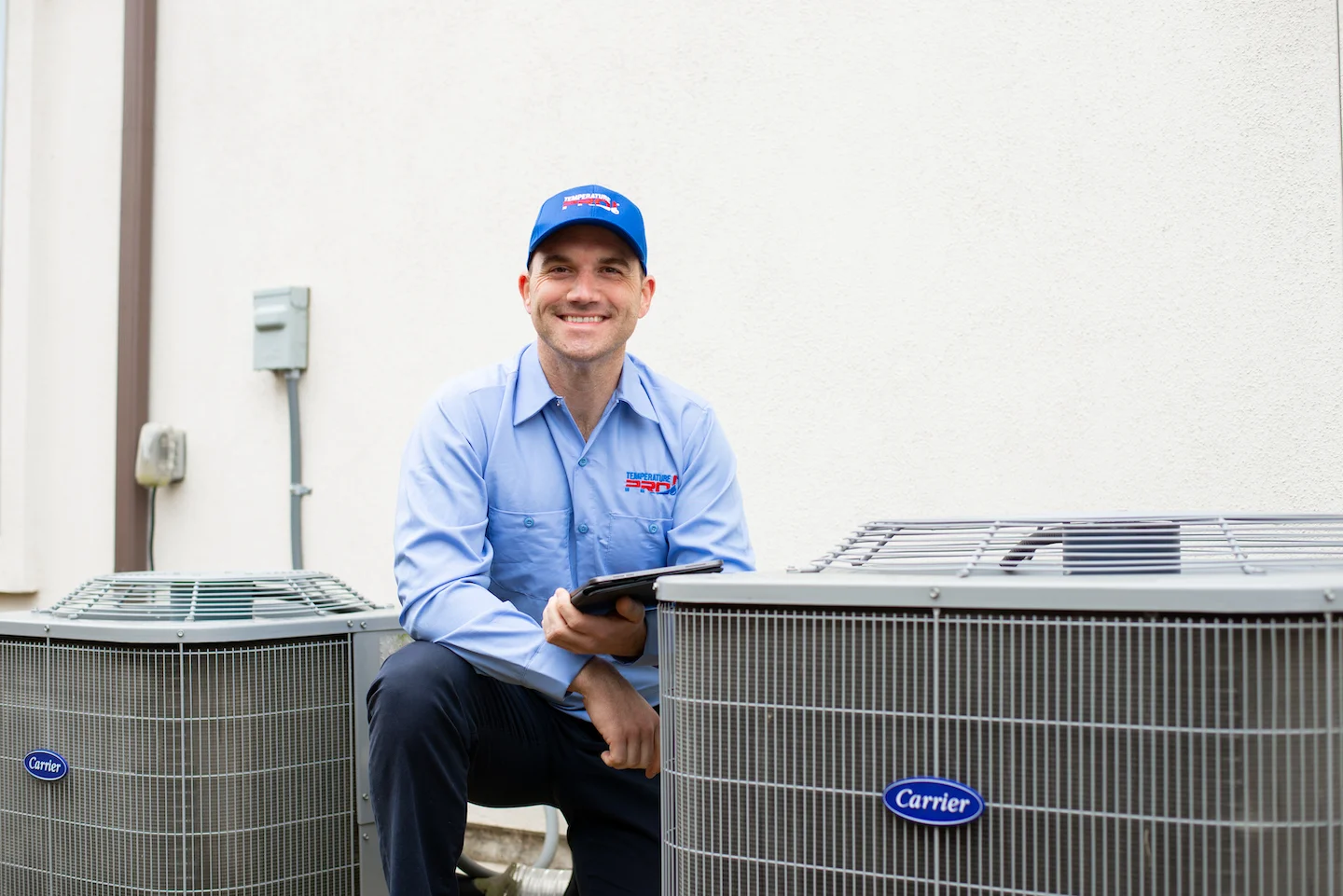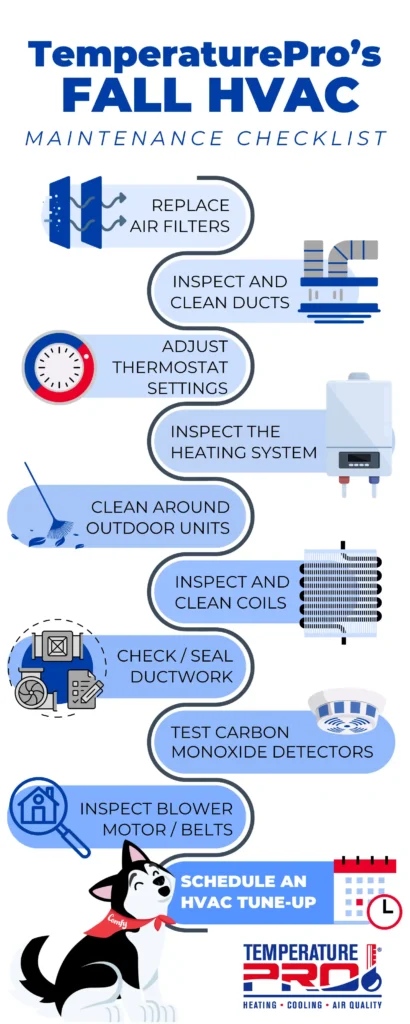As the fall season approaches, ensuring your HVAC system is in top-notch condition is crucial for maintaining a comfortable and energy-efficient home. Fall is the perfect time to perform essential maintenance tasks to prepare your heating system for the colder months ahead.
Fall HVAC Maintenance Checklist
In this comprehensive guide, we’ll provide you with a detailed checklist, expert advice, and helpful visuals to ensure your HVAC system runs smoothly. Plus, we’ll encourage you to schedule a professional HVAC tune-up with TemperaturePro to guarantee optimal performance. We always have fall specials and promos going on for our dedicated customers, so be sure to schedule at the end of this list before slots fill up!
The Main Fall HVAC Maintenance Checklist:
- Change Air Filters
- Inspect and Clean Ducts
- Check Thermostat Settings
- Inspect the Furnace
- Clean Around Outdoor Units
- Inspect and Clean Coils
- Check and Seal Ductwork
- Test Carbon Monoxide Detectors
- Inspect Blower Motor and Belts
- Schedule a Professional Tune-Up
1. Change Air Filters
Changing your air filters is one of the simplest yet most important maintenance tasks. Dirty or clogged filters can restrict airflow, reduce efficiency, and increase energy bills. Clean air filters are essential for maintaining efficient airflow and indoor air quality. Dirty filters can lead to higher energy bills and increased strain on your HVAC system.
TemperaturePro Expert Advice: Our TemperaturePro Tech Professionals recommend changing your air filters every 1-3 months, depending on the type of filter and your household conditions. High-efficiency filters may last longer, but it’s essential to check them regularly.
2. Inspect and Clean Ducts
Clean ducts ensure efficient airflow and maintain indoor air quality. Over time, ducts can accumulate dust, debris, and even mold, which can affect your HVAC system’s performance and your health. Clean ducts prevent the buildup of dust and allergens, ensuring your HVAC system runs efficiently and your indoor air remains clean.
TemperaturePro Expert Advice: Consider hiring a professional to inspect and clean your ducts every 3-5 years. If you notice significant dust buildup or experience allergy symptoms, it might be time for an earlier inspection. With our Indoor Air Quality Partner AtmosAir, we provide state-of-the-art Air Quality Solutions that can prevent things like mold, dust and allergens from getting into your home. If you’re looking for an Indoor Air Quality solution, find your local TemperaturePro and call for more info!
3. Check Thermostat Settings
Ensure your thermostat is set to the appropriate temperature for fall. Programmable thermostats can help you save energy by automatically adjusting the temperature based on your schedule. Proper thermostat settings help optimize energy usage, reducing your heating bills and ensuring a comfortable home environment.
TemperaturePro Expert Advice: Setting your thermostat to lower temperatures while you’re away from home or sleeping can significantly reduce energy consumption. Aim for a comfortable 68-72°F when you’re home and awake. TemperaturePro offers programmable and smart thermostats that work seamlessly with your existing system. Find out more by calling your local TemperaturePro today!
4. Professionally Inspect the Furnace
Your furnace is the heart of your heating system. Regular maintenance and professional inspections can help identify potential issues before they become major problems. Regular furnace inspections can identify potential issues early, preventing costly repairs and ensuring your heating system operates safely.
TemperaturePro Expert Advice: Have one of our TemperaturePro professional HVAC technicians inspect your furnace annually. They’ll check for signs of wear, clean components, and ensure everything is functioning correctly.
5. Clean Around Outdoor Units
Debris such as leaves, grass, and dirt can accumulate around your outdoor HVAC units, obstructing airflow and reducing efficiency.
TemperaturePro Expert Advice: Regularly clear the area around your outdoor units, ensuring at least two feet of clearance on all sides. This simple step can prevent overheating and improve performance. Raking leaves & blowing away dust and debris is all you need to do yourself – your TemperaturePro Tech can professionally clean your unit to ensure efficient air flow.
6. Professionally Inspect and Clean Coils
Both your evaporator and condenser coils can accumulate dirt over time, reducing their ability to absorb and dissipate heat effectively. Clean coils are crucial for effective heat exchange. Dirty coils reduce efficiency and can lead to higher energy consumption.
TemperaturePro Expert Advice: If you notice significant buildup, consider scheduling a professional cleaning. Your coils need to be professionally cleaned at least once a year. (Bonus Tip! Our ProPlan Maintenance Plan will keep track of all of your maintenance visits, priority scheduling, and give you discounts on major services! Learn more by visiting our ProPlan page.
7. Check and Professionally Seal Ductwork
Leaky ducts can lead to significant energy loss and decreased efficiency. Inspect your ductwork for any visible signs of leaks or damage. Sealing duct leaks prevents energy loss, improves efficiency, and ensures your home heats evenly.
TemperaturePro Expert Advice: Your TemperaturePro Tech can perform an inspection and give you a full report on the state of your ductwork. We can also repair your ductwork if we find anything, such as leaky ducts, dust and debris, or other problems.
8. Test Carbon Monoxide Detectors
Safety is paramount. Ensure your carbon monoxide detectors are functioning correctly to protect your household from this dangerous gas.
TemperaturePro Expert Advice: Test your detectors monthly and replace the batteries at least once a year. Consider replacing units that are over seven years old.
9. Professionally Inspect Blower Motor and Belts
The blower motor and belts are essential components of your HVAC system. Regular inspections can prevent unexpected breakdowns.
TemperaturePro Expert Advice: Listen for unusual noises from the blower motor, and check the belts for signs of wear or fraying. Replace any worn-out parts promptly by contacting your local TemperaturePro.
10. Schedule a Professional Tune-Up
While DIY maintenance is essential, a professional tune-up ensures your system is thoroughly inspected and maintained by experts.
TemperaturePro Expert Advice: Schedule a professional HVAC tune-up with TemperaturePro to guarantee your system is ready for the fall and winter months. Our technicians will perform a comprehensive inspection, cleaning, and adjustment of your HVAC system.
Your Comprehensive Handy Fall HVAC Checklist
We know how busy your life is, and as we prepare for the upcoming cooler months, the to-do list keeps adding up. We took the liberty to create a handy checklist for you to remember what to do to ensure you aren’t caught in the cold.
Prep Correctly for Fall: Schedule Your Professional HVAC Tune-Up Today
Ensure your HVAC system is ready for the fall and winter months by scheduling a professional tune-up with TemperaturePro. Our experienced technicians will perform a comprehensive inspection, cleaning, and adjustment of your system, guaranteeing optimal performance and energy efficiency.
Book your HVAC tune-up now: Find Your Local TemperaturePro
By following this comprehensive fall HVAC maintenance checklist and scheduling a professional tune-up with TemperaturePro, you’ll ensure your heating system operates efficiently, keeping your home comfortable and your energy bills low throughout the colder months.
Research and Reputable Sources
To ensure the accuracy and reliability of the information provided, we’ve referenced the following reputable sources:
- Energy Star: Fall HVAC Maintenance Tips
- Department of Energy: Seasonal Maintenance Checklist
- American Society of Heating, Refrigerating and Air-Conditioning Engineers (ASHRAE)
- Environmental Protection Agency (EPA): Indoor Air Quality







